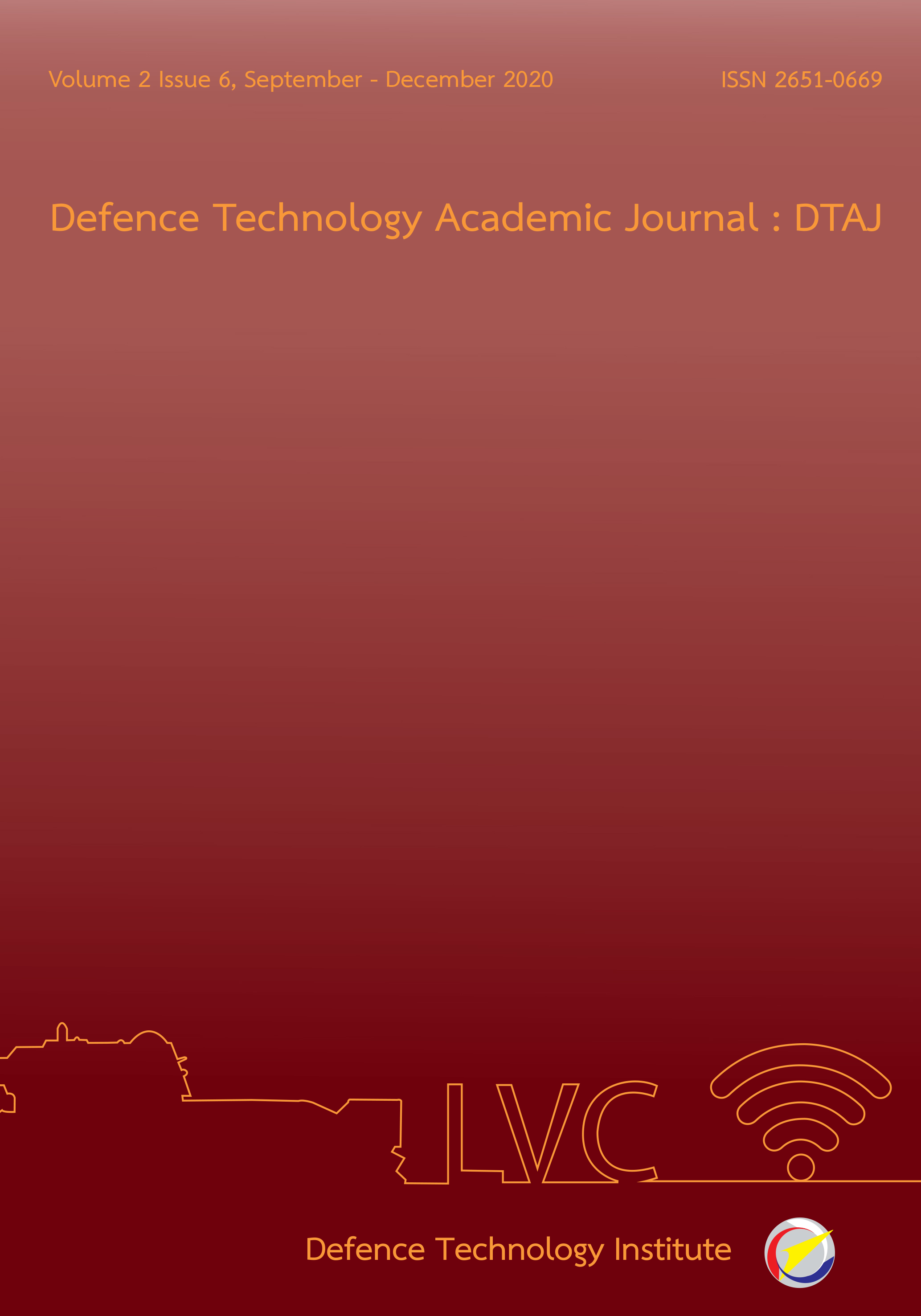ผลของการวางเรียงตัวของแผ่นเกราะต่อประสิทธิภาพการกันกระสุน
Main Article Content
บทคัดย่อ
แผ่นเกราะกันกระสุนเหล็กกล้าสามารถสร้างมาเป็นแผ่นชั้นเดียวหรือหลายชั้นซ้อนกันได้ ซึ่งการจัดวางชั้นย่อมส่งผลต่อประสิทธิภาพการกันกระสุนของแผ่นเกราะ งานวิจัยนี้จึงมีเป้าหมายเพื่อวิเคราะห์ผลของการเรียงตัวของแผ่นเกราะต่อประสิทธิภาพการกันกระสุน โดยแผ่นเกราะที่ศึกษาคือ แผ่นเหล็กกล้าประเภท Armox500T และใช้การทดสอบยิงด้วยกระสุนตามมาตรฐาน National Institute of Justice (NIJ) ระดับ 3 ผลการทดลองแสดงให้เห็นถึงลักษณะการเสียรูปของแผ่นเหล็ก ซึ่งเป็นข้อมูลที่สามารถนำไปใช้สอบเทียบกับการวิเคราะห์ด้วยแบบจำลองไฟไนต์เอลิเมนต์ของการยิงด้วยกระสุนจริง โดยผลของการคำนวณในแบบจำลองให้ความหนาหลังการเสียรูปและขนาดของรูเจาะทะลุของแผ่นเกราะที่มีค่าใกล้เคียงกับผลการทดสอบ แบบจำลองที่ถูกสอบเทียบถูกนำไปปรับเพื่อศึกษาถึงผลกระทบของการวางเรียงของแผ่นเกราะและผลของความหนาของแผ่นเกราะ ผลการวิเคราะห์แสดงให้เห็นว่าแผ่นเกราะที่ทำจากเหล็กกล้าสองชั้นมีความสามารถในการลดพลังงานการกระแทกของกระสุนได้มากกว่าเหล็กกล้าชั้นเดียวที่ความหนาเท่ากัน เพราะแผ่นบางสามารถโก่งได้มากกว่า และเสียรูปมากกว่าด้วย
Downloads
Article Details

อนุญาตภายใต้เงื่อนไข Creative Commons Attribution-NonCommercial-NoDerivatives 4.0 International License.
Journal of TCI is licensed under a Creative Commons Attribution-NonCommercial-NoDerivatives 4.0 International (CC BY-NC-ND 4.0) licence, unless otherwise stated. Please read our Policies page for more information...
เอกสารอ้างอิง
Alavi Nia, A., Hoseini, G.R. “Experimental study of perforation of multi-layered target by hemispherical-nosed projectiles”, Materials
and Design, 32, 2011, pp. 1057-1065.
Almohandes, A.A., Abdel-Kader, M.S., Eleiche, A.M. “Experimental investigation of the ballistic resistance of steel-fiberglass reinforced polyester laminated plates”, Composites Part B: Engineering, 27(5), 1996, pp. 447-458.
Corran, R.S.J., Shadbolt, P.J., Ruiz, C. “Impact loading of plates – an experimental investigation”, International Journal of Impact
Engineering, 1(1), 1983, pp. 3-22.
Gupta, N.K., Madhu, V. “An experimental study of normal and oblique impact of hard-core projectile on single and layered plates”, International Journal of Impact Engineering, 19(97), 1997, pp. 395-414.
Palta, E., Gutowski, M., Fang, H.B. “A numerical study of steel and hybrid armor plates under ballistic impacts”, International Journal of Solids and Structures, 136-137 (2018), pp. 279-294.
Zukas, J.A., Scheffler, D.R. “Impact effects in multilayered plates”, International Journal of Solids and Structures, 38, 2001, pp. 3321-3328.
Holmen, J.K., Solberg, J.K., Hopperstad, O.S., Borvik, T. “Ballistic impact of layered and case-hardened steel plates”, International
Journal of Impact Engineering, 110, 2017, pp. 4-14.
Liu, J.F., Long, Y., Ji, C., Liu, Q., Zhong, M.S., Ge, S. “Ballistic performance study on the composite structures of multi-layered targets subjected to high velocity impact by copper EFP”, Composite Structures, 184, 2018, pp. 484-496.
Liu, J.F., Long, Y., Ji, C., Liu, Q., Zhong, M.S., Zhou, Y. “Influence of layer number and air gap on the ballistic performance of multi-layered targets subjected to high velocity impact by copper EFP”, International Journal of Impact Engineering, 112, 2018, pp. 52-65.
Serjouei, A., Gour, G., Zhang, X.F., Idapalapati, S., Tan, G.E.B. “On improving ballistic limit of bi-layer ceramic-metal armor”, International Journal of Impact Engineering, 105, 2017, pp. 54-67.
Ben-dor, G., Dubinsky, A., Elperin, T. “On the ballistic resistance of multi-layered targets with air gaps”, International Journal of Solids and Structures, 35(23), 1998, pp. 3097-3103.
Elek, P., Jaramaz, S., Mickovic, D. “Modeling of perforation of plates and multi-layered metallic targets”, International Journal of Solids and Structures, 42, 2005, pp. 1209-1224.
Iqbal, M.A., Senthil, K., Sharma, P., Gupta, N.K. “An investigation of the constitutive behavior of Armox 500T steel and armor piercing incendiary projectile material” International Journal of Impact Engineering, 2016, pp. 146-164.
ABAQUS Documentation, Simulia. [15] Adam, B (2003). “Simulation of ballistic impacts on armored civil vehicles” Master Thesis, Eindhoven University of Technology, The Netherlands.


